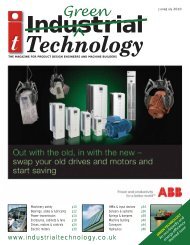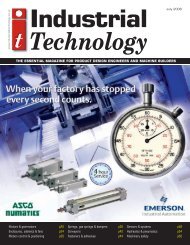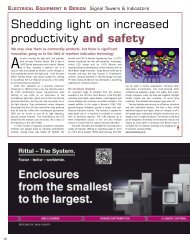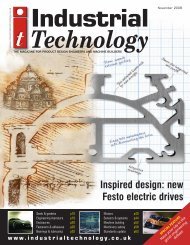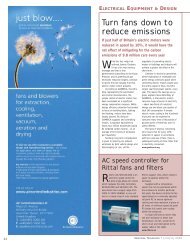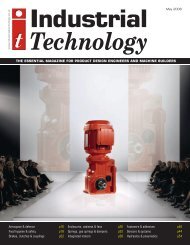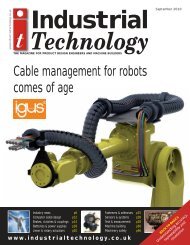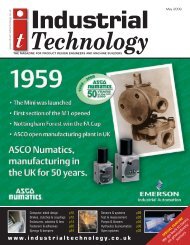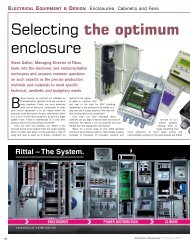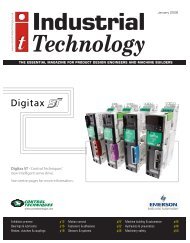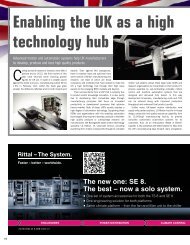drives & controls - Industrial Technology Magazine
drives & controls - Industrial Technology Magazine
drives & controls - Industrial Technology Magazine
Create successful ePaper yourself
Turn your PDF publications into a flip-book with our unique Google optimized e-Paper software.
MACHINE BUILDING & AUTOMATIONMachinery SafetyA better way to build barriersUnprotected hazardous zones in work and transport areas posea serious threat to personnel. In the past, however, the designand installation of effective protective barriers have been costly,inconvenient and time-consuming processes. Now there’s abetter way, says Mark Dash of Bosch RexrothTraditionally, protective barriers have been customfabricated from steel. Provided that the designand fabrication work is carried out properly andto the relevant standards, the result is effective inachieving the required levels of safety but, in terms ofconvenience, cost and ease of modification, steel barriersleave a lot to be desired. An attractive alternative is,however, now available in the form of modular aluminiumbarrier systems, and it’s instructive to see how thesecompare with their traditional counterparts.Let’s start with the design process. With a steelbarrier, ensuring that the relevant safety standards –usually some combination of EN292, EN294 and EN811– are met is entirely in the hands of the designers. Theymust ensure, for example, that the spaces between theelements making up the barrier are sufficiently small toprevent the entry of upper or lower body limbs, or evenfingers, as required by the application. There may also berequirements to contain projectiles – items that areejected, usually under fault conditions, by the equipmentaround which the barrier is being constructed.With prefabricated barrier systems, the design processis much faster, easier and more certain. Simply pickingsuitable elements from the manufacturer’s catalogue willensure that, provided the simple assembly guidelines arecorrectly followed, safety requirements are metautomatically. In addition, the wide range of elementsavailable, which invariably include such items as doors inslide and swing formats, means that there is virtually nolimit of the types of barrier that can be configured. As afurther aid to the design process, the best modularguarding systems are complemented by dedicated CADsoftware that makes the processes of configuringcomplete assemblies and generating parts lists fast andeasy. But if modular systems simplify and speed thedesign process, they do even more for the fabricationstage – in fact, they eliminate it entirely.The aluminium barrier elements are manufactured bythe supplier under controlled conditions that ensurequality and uniformity. Because these are standardelements held in stock, deliveries are fast, in markedcontrast to the delays inevitably associated with thecustom fabrication of steel barriers. With modularaluminium barriers, the only work that has to be done onsite is installation. Once again, this is straightforward fastand convenient. Usually, the only requirement is to drillfoundation holes for the barrier supporting posts and erectthem, and then add the barrier elements to complete thesystem. As the barriers are developed from standardaluminium profile sections, only hand tools are needed formounting and assembly.Fast and inexpensive installationUnlike their steel counterparts, modular aluminiumbarriers require no cutting, welding and painting on site.In addition, because installation is so straightforward, itcan be successfully carried out by personnel withrelatively low levels of skill. Installation is also fast andtherefore inexpensive. Other major benefits of modularaluminium barriers include the light weight and their highresistance to corrosion.The lightweight but strong construction is a great aidduring installation and means that, in many cases, thework can be carried out by just one person. In contrast,the sections of a fabricated steel barrier, which size-forsizetypically weigh three times as much, invariablyrequired the efforts of several people to manoeuvre theminto position. Aluminium is, of course, inherently resistantto corrosion. In almost every case, however, steel needs tobe painted, which adds to costs. Further, if a steel barrieris scratched or otherwise damaged, corrosion rapidly setsin unless remedial action is taken, whereas scratching analuminium barrier has no effect whatsoever. Interestingly,aluminium barriers can be painted, if required. It issometimes desirable, for example, to paint them yellow sothat they are easy to see, or black so that it is easier tosee through them and observe the equipment that theyare surrounding.An area where aluminium modular barriers reallyscore over steel is ease of modification. If changes areneeded to an aluminium system, the work is limited toadding, removing and reconfiguring sections, using onlysimple hand tools. The most difficult requirement that willbe encountered is adding or re-positioning a support post.With steel systems, modifications are, in contrast, costlyand inconvenient. Cutting, welding and repainting on siteare almost sure to be needed, along with detailed designwork to ensure that the new configuration continues tomeet the appropriate safety requirements.Last but not least, aluminium barriers have a pleasingmodern appearance that complements the latestmachinery. That perhaps doesn’t seem important, buteveryone benefits from an attractive working environment,and those accountants and managers who controlbudgets are surprisingly often influenced by appearances.Modular aluminium barrier systems, such as EcoSafefrom Bosch Rexroth, are versatile, dependable and,particularly when their low design and installation costsare taken into account, they are offer significant costsavings compared with conventional steel barriers. Withso much in favour of the aluminium solution, whatpossible reason could there be for specifying any othertype of protective barrier?MORE INFORMATION:Enter J606 on the enquiry card, or visit ‘latest issue stories’www.industrialtechnology.co.uk for further details from Bosch Rexrothand more news on machinery safety60INDUSTRIAL TECHNOLOGY • October 2008



